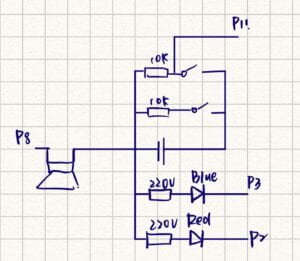
To be honest, recitation 2 is much easier than recitation 1, partly because I was more familiar with the breadboard and partly because the demands were more detailed so that it was easier to follow.
I did spend a few minutes to make clear which two ports can make it right. It was so confusing to me why 5V and D9 weren’t able to light up the LED, and then professor Minsky told me we need a “ground” to enable the current to flow, which solved my question left on the last course.
The circuit 2: toneMelody, was very adorable even if I know nothing about music and couldn’t make my own song with it (which is what two boys next to me did. How nice!).
Problems occurred when I built up the circuit 3: Speed Game mainly because of my carelessness. I missed two wires connected to the LED so at first I could only hear the sound without my victory light! This process taught me to be focused even when I was copying the answer! (Just kidding.)
And this is my own drawing of the schematic for circuit 3:

QUESTION 1:
One of the buttons we can use is the cardboard button we made last time. To press it without making it move away is difficult to achieve, which makes the game more disordered but more interesting.
QUESTION 2:
As explained in the slide, the 10 kOhm resistor works as a “PULL-DOWN RESISTOR”, providing a connection to Ground and making the circuit works well when the button is not pressed.
QUESTION 3:

I choose this one simply because I really love this idea and would like to have a try if I find a bad potato in the kitchen (just kidding).
First of all, I can find this brilliant idea because of the “collaboration concept”. People share their designs on relevant websites so that everyone can copy and edit it, using Arduino to do more things.
Secondly, I think it’s a kind of using junks (if the potato is not good enough to eat) and hacking toys (maybe).
All in all, this is a very interesting and creative project, because it follows “the Arduino way” to a large extent and can give me some inspiration.
Work cited
Lamborghini, A. (n.d.). Circuit design #tinkercad10. Tinkercad. Retrieved September 27,
2022, from
https://www.tinkercad.com/things/4hnh4bEAW6x